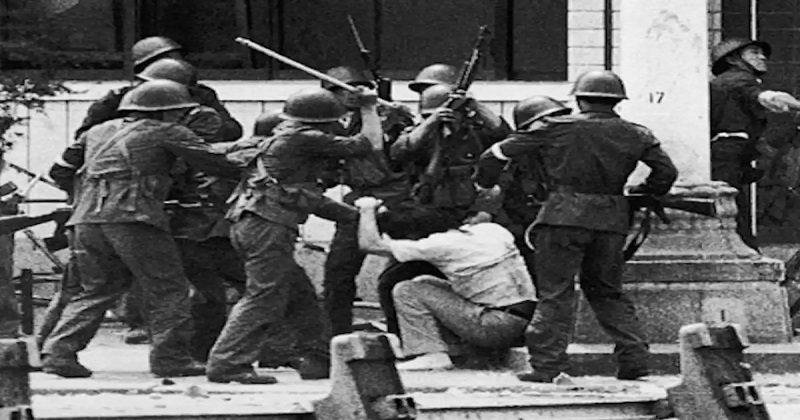
Multiple individuals have been detained in Hong Kong as authorities pounce on any effort at public remembrance of the 33rd anniversary of the Tiananmen Square crackdown, as China seeks to erase any traces of the atrocity. Discussion of the events of June 4, 1989, when China unleashed troops and tanks on nonviolent demonstrators, is almost prohibited on the Chinese mainland. Until two years ago, when Beijing implemented a national security law to suffocate dissent following massive pro-democracy demonstrations in 2019, semi-autonomous Hong Kong was the only area in China where large-scale remembering was still authorised.
Saturday commemorated the 33rd anniversary of China’s violent crackdown on pro-democracy protests in and around Tiananmen Square in downtown Beijing, when Chinese forces opened fire on their own people. The incident is still forbidden in mainland China and will not be remembered publicly by the ruling Communist Party or government. But what exactly was the Tiananmen Square massacre, and what led to it? We go through some key dates leading up to the protests and the subsequent crackdown:
1988: China enters economic upheaval as a result of panic purchasing sparked by increasing inflation that approaches 30%.
April 15, 1989: Hu Yaobang, a prominent reformer and former Communist Party head, dies on April 15, 1989. His death exacerbates dissatisfaction with the sluggish pace of change, as well as corruption and wealth disparity.
April 17: Protests in Tiananmen Square began on April 17, with students asking for democracy and change. Despite government warnings, crowds of up to 100,000 form.
April 22; 50,000 students assemble outside the Great Hall of the People for Hu’s mourning service. Three students seek to bring a petition to the government expressing their requests, but are turned down. Rioting and looting occur in Xian and Changsha.
April 24: Beijing students begin classroom strike.
April 27: Around 50,000 students march to Tiananmen Square on April 27th, defying authorities. There are up to a million supporters.
May 2; 10,000 demonstrators marched on the city government offices in Shanghai.
May 4; Additional huge protests coincide with the anniversary of the 1919 May 4 Movement, which was spearheaded by students and intellectuals. Protests clash with an Asian Development Bank gathering in the Great Hall of the People. Students march in nine locations, including Shanghai.
May 13;Hundreds of students stage a hunger strike at Tiananmen Square
May 15-18; Protests prohibit the customary greeting ceremony outside the Great Hall of the People for reforming Soviet leader Mikhail Gorbachev’s state visit, to China’s shame. Students greet Gorbachev as the ‘Ambassador of Democracy’.
May 19: Party chairman Zhao Ziyang meets students in Tiananmen Square, accompanied by hardline then-premier Li Peng and future premier Wen Jiabao. Zhao begs the students demonstrators to leave, but they refuse. This is Zhao’s last public appearance. He is later cleansed.
May 20; Li proclaims martial law in portions of Beijing. Many still see Li as the ‘Butcher of Beijing,’ and he remained premier until 1998.
May 23; 100,000 people marched in Beijing to demand Li’s dismissal.
May 30: Students present the 10-metre (33-foot) high ‘Goddess of Democracy,’ modelled after the Statue of Liberty, in Tiananmen Square.
May 31: Students are referred to as ‘traitorous bandits’ in a government-sponsored counter-demonstration.
June 3; citizens resist a charge by hundreds Chinese soldiers aimed at Tiananmen Square. Tear gas and gunshots were used in running battles around the plaza. Protesters are warned that military and police have the ‘right to employ any tactics’.
June 4: Tanks and armoured personnel carriers launch an early-morning assault on the plaza, clearing it before daybreak. Four hours later, military open fire on unarmed citizens reassembling at the square’s perimeter.
June 5; An unidentified Chinese guy stands in front of a tank convoy departing Tiananmen Square. The image has travelled throughout the world as a sign of defiance against the crackdown.
June 6; Chinese State Council spokesperson Yuan Mu stated on television that the known death toll was over 300 people, the majority of them were troops, with just 23 students definitely slain. China has never released an official death toll, but rights organisations and witnesses estimate it might be in the hundreds.
June 9: Deng Xiaoping praises military officers and blames the demonstrations on counter-revolutionaries aiming to destabilise the party.

Post Your Comments